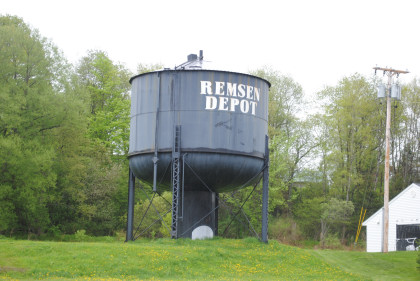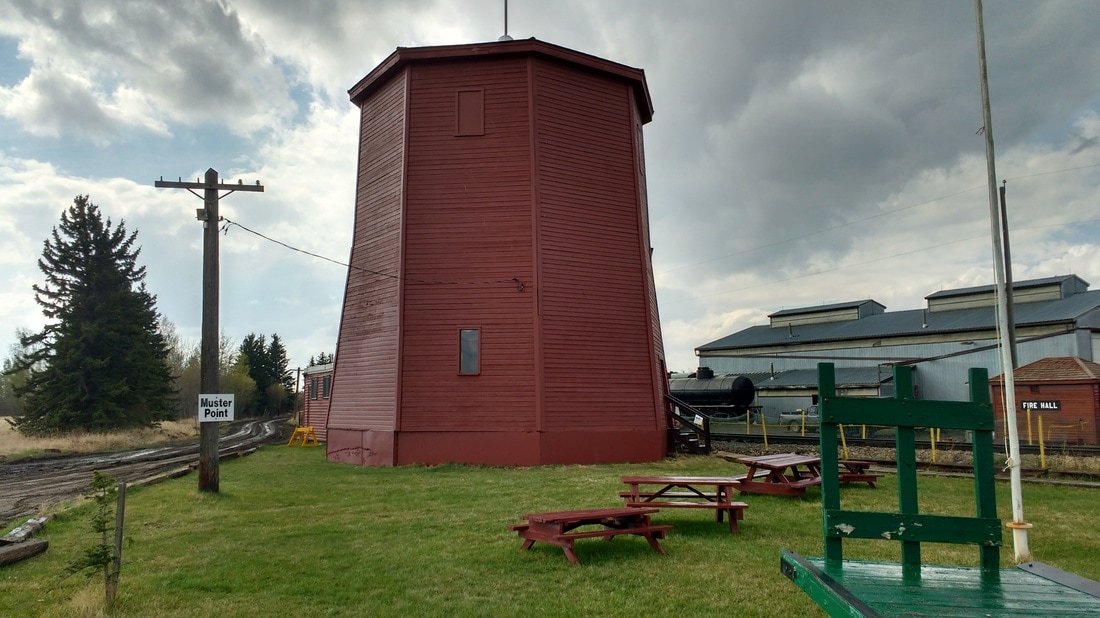Hi everyone. Today, in an agricultural landscape, I noticed lots of water tower. What is the exact use for this and why this has to be up in the air? Maybe my question is stupid but it’s the first time I am asking myself about it ![]()
They provide hydrostatic water pressure at meaningful volume without having to coordinate pumps with demand flow.
A comparatively small volume of water at high elevation pressurizes everything below it; getting a large volume at high elevation explains the shape of many modern towers.
Pumps cannot maintain pressure well or move water fast enough in services where it is desired to move a lot of water quickly. So, water is pumped at whatever quantity/rate a pump can into a storage tank that is up in the air. Then when water is desired to be delivered somewhere you can open a valve and it will gravity flow out at a relatively constant rate and pressure. The tank can be refilled over time at a lower rate than the usage and the pressure at the output will be uniform all the time.
SV’s post also hints at why you see different sized water towers (standpipes is a more official name). A small town won’t need the reserve a large city requires.
Water towers are also a function of the topography. In hilly areas, there may be an in-ground tank atop one of the hills, so you won’t see a water tower at all. On the plains, they’ll be everywhere.
One PSI requires a water column of just over 28". So if the desired pressure is 40 PSI at a given point on the system, the standpipe will need to be something over 100’ tall. This point will likely be around the widest part of an onion shaped tower, or the middle of an elevated cylindrical tank. The size of the pipe leading up to the tank is governed by the desired flow.
Something we in the fire service have to watch out for with small water systems is the fact that we can over-run the system’s capabilities during a large fire event. Most systems will sustain large fire flows for only a couple of hours.
Railroad water towers don’t need to generate pressure - they’re more interested in how quickly they can get water into the tender. They were often filled by some trickle from a nearby stream, or perhaps a windmill driving a pump. Even five gallons a minute adds up.
I read of one tower on a logging railroad that was kept filled by a Rife Hydraulic Ram - a fascinating device in and of itself. They are self powered by the flowing w
I grew up in a small town in Upcountry South Carolina, and the city water system made use of a tank (I have no idea as to its capacity) about forty feet above the ground. Some towns used what seemed to be a large standpipe (I saw them from a distance).
In 1948 I spent a few days on a farm near Ronceverte, West Virginia (ome of my brothers was marrying the daughter of the owner). At that time, the water for the house came from a ram that was some distance away.
RailroadXplorer (2-17):
Perhaps I’m a bit dense, but your new thread confuses me, as I’m not sure what you are referring to. This is a railroad forum, but yet you mention agriculture. Water towers that I am most familiar with are old abandoned steam engine watering towers …

Red Rock, AZ, September 30, 2016
… and municipality water towers by railroad tracks.

Eloy, AZ, August 5, 2008
Could you set me straight on what you are inquiring about?
Oh, by the way, you are rather new here. Welcome to the forum, and great having you among us!
Best,
K.P.
My old home of Newton, KS has a city ground level tank next to the BNSF La Junta Sub mainline. It holds 3.6 million gallons of ready-to-use water. Prior to being built in 1938 the land on the site was owned by SF. The city bought the trac of land. Today the structure is in horible shape. One can tell the tank leaks bad. Likely in very bad shape on the inside. City keeps putting off repair work. Tank was last drained, inspected, cleaned and painted in 1997.
It might be interesting to note that there is one old railroad water tank that is still standing, here in Kansas.
In 1885, the SL-SF RR built a 50,000 gal wooden water tank; on the line that ran East from Wichita, via Augusta,Beaumont, Sedan, and Independence,to Baxter Springs, and into Carthage, Mo.,area. This tank is on the National Register of Historic Places. This line was ‘lffted’ [in stages] sarting in the late 1960’s.
Photo of tank, linked @ http://photos.legendsofamerica.com/ks-railroad/h1EE2594F#h1ee2594f
The Beaumont tank actually was on the Wichita-Monnet line of Frisco. The Beaumont Hotel, next to the tower, is worth a stop. Good home cooking. We would like to spend a night there sometime. In the cafe, there are several rr items displayed including a story manuscript of the rr @ Beaumont written by yours truly.
Water towers also exist in the urban enviornment where multi-story buildings have the need to maintain adequate water pressure for both the users and for fire fighting. Yesterday (2/17) Discover Channel had a Dirty Jobs marathon - one of the episodes followed a crew in New York City the disassembled and rebuilt a water tower on top of a building.
Here is a water tank that is set in the ground.
https://www.bing.com/maps?cp=40.789063|-111.871463&style=h&lvl=18&v=1
You may have to scroll up to see the tank.
I don’t know if my water comes from there now, but when I lived on 18th Avenue (SW corner of of Hilltop and 18th Avenue), my water came from there.
The A&WP RR built an ~ 10,000 gal concrete water tank. It had a hydralic ram that worked off a small creek. Even today that creek seems to always have some flow. The tank is still in place on the CSX line although the fill spout is long gone, It has a padlocked lower room unused now by the RR.
Apartment buildings in New York City all seem to have wooden water towers on the roof. They look just the same as the water towers that railroads used. I saw a new one at a summer camp in Sullivan county, N.Y. and it was leaking. The guy said that they all do that until the wood swells and seals it up. Building them is a trade that won’t die, I suppose.
In Iowa, at least, rural water districts have been formed. Instead of using individual wells, people on farms and acerages (and industrial users, too) can
Wow, thanks everyone for all the infos. I was talking mostly about city water tank but I tought there were more railroad water tank than only one.
There are plenty of railroad water tanks around. Wooden versions that weren’t specifically being maintained are probably long gone, but steel and concrete types can still be found.
Remsen, NY:

Deshler still has it’s B&O water tower and resivouirs.
stay safe
Joe
At the end of the steam locomotive era, Southern Pacific donated many of theirs to the local communities, including the one pictured at Red Rock in K.P.'s post and the one in Maricopa that shows up in many photos of the Amtrak station there.
John Timm
Indeed, wood structures do not last long when left to the elements.
We have one of the few remaining wooden tanks in Western Canada, it is enclosed and contains a coal stove to keep the water from freezing in winter. It was originally located at Gibbons, AB, a few miles north of the Museum site:

More photos from its most recent restoration job:
https://barryc53.weebly.com/gibbons-water-tank.html
Only a few like it are left. It is no longer useable (the wooden tank and support beams have dried out and weakened with time, and it would not be watertight or safe) but is still an impressive structure.
The entire structure also has a slight twist, from being struck by the remnants of the 1987 Edmonton Tornado, which ended its destructive, fatal run just south of the Museum site.
Cranbrook, B.C. has preserved its CPR wood water tank, also enclosed in a wood shed although of a somewhat different design than the ex-Gibbons CN example. It was moved across the tracks from its original location to the museum grounds.